Child Abuse Prevention: Effects and Biblical Perspectives
VerifiedAdded on 2022/11/28
|14
|3945
|83
Essay
AI Summary
This essay delves into the critical issue of child abuse, examining its prevalence, effects, and potential prevention strategies. It begins by defining child abuse and highlighting its significance as a social and public health problem, particularly within the United States. The essay explores the increasing rate of child abuse cases, citing statistical data from Childwelfare.gov and other studies, and discusses the wide-ranging impacts on children, including psychological problems, behavioral issues, and cognitive deficits. Furthermore, the essay incorporates a biblical perspective on child abuse, emphasizing the importance of parental responsibility and the need for societal intervention. It concludes by underscoring the importance of child abuse prevention, referencing the profound and lasting consequences of child maltreatment and advocating for proactive measures to safeguard children.
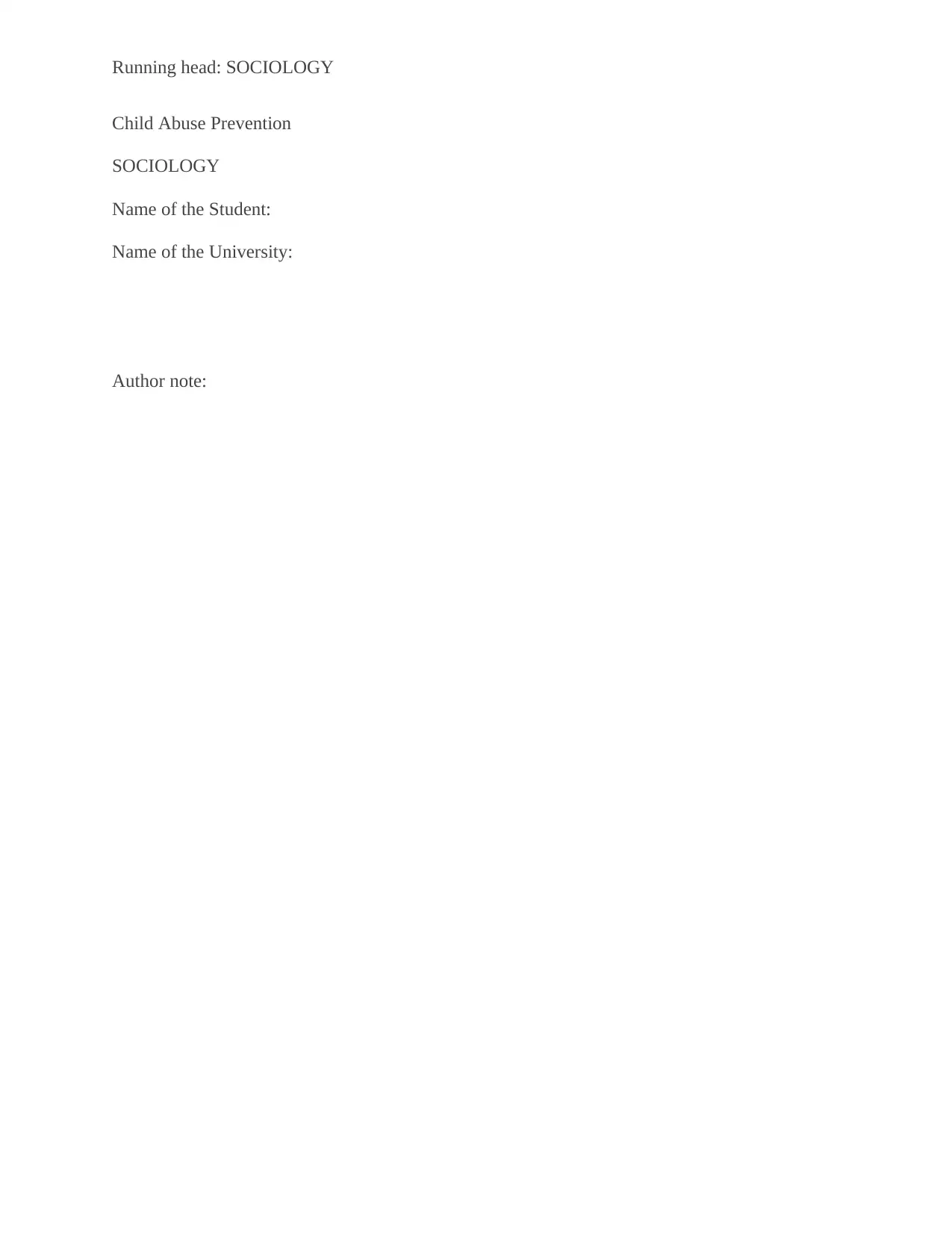
Running head: SOCIOLOGY
Child Abuse Prevention
SOCIOLOGY
Name of the Student:
Name of the University:
Author note:
Child Abuse Prevention
SOCIOLOGY
Name of the Student:
Name of the University:
Author note:
Paraphrase This Document
Need a fresh take? Get an instant paraphrase of this document with our AI Paraphraser
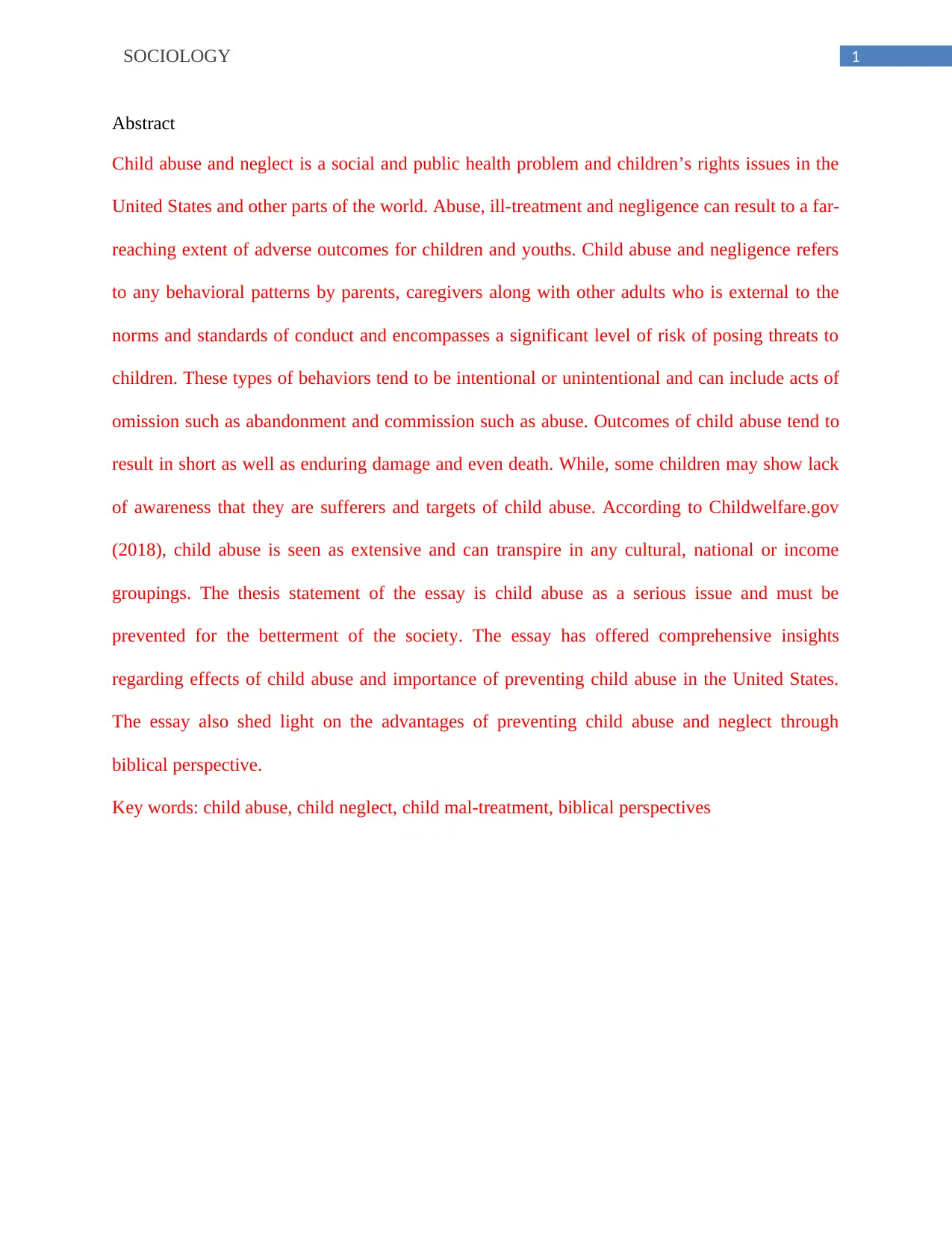
1SOCIOLOGY
Abstract
Child abuse and neglect is a social and public health problem and children’s rights issues in the
United States and other parts of the world. Abuse, ill-treatment and negligence can result to a far-
reaching extent of adverse outcomes for children and youths. Child abuse and negligence refers
to any behavioral patterns by parents, caregivers along with other adults who is external to the
norms and standards of conduct and encompasses a significant level of risk of posing threats to
children. These types of behaviors tend to be intentional or unintentional and can include acts of
omission such as abandonment and commission such as abuse. Outcomes of child abuse tend to
result in short as well as enduring damage and even death. While, some children may show lack
of awareness that they are sufferers and targets of child abuse. According to Childwelfare.gov
(2018), child abuse is seen as extensive and can transpire in any cultural, national or income
groupings. The thesis statement of the essay is child abuse as a serious issue and must be
prevented for the betterment of the society. The essay has offered comprehensive insights
regarding effects of child abuse and importance of preventing child abuse in the United States.
The essay also shed light on the advantages of preventing child abuse and neglect through
biblical perspective.
Key words: child abuse, child neglect, child mal-treatment, biblical perspectives
Abstract
Child abuse and neglect is a social and public health problem and children’s rights issues in the
United States and other parts of the world. Abuse, ill-treatment and negligence can result to a far-
reaching extent of adverse outcomes for children and youths. Child abuse and negligence refers
to any behavioral patterns by parents, caregivers along with other adults who is external to the
norms and standards of conduct and encompasses a significant level of risk of posing threats to
children. These types of behaviors tend to be intentional or unintentional and can include acts of
omission such as abandonment and commission such as abuse. Outcomes of child abuse tend to
result in short as well as enduring damage and even death. While, some children may show lack
of awareness that they are sufferers and targets of child abuse. According to Childwelfare.gov
(2018), child abuse is seen as extensive and can transpire in any cultural, national or income
groupings. The thesis statement of the essay is child abuse as a serious issue and must be
prevented for the betterment of the society. The essay has offered comprehensive insights
regarding effects of child abuse and importance of preventing child abuse in the United States.
The essay also shed light on the advantages of preventing child abuse and neglect through
biblical perspective.
Key words: child abuse, child neglect, child mal-treatment, biblical perspectives
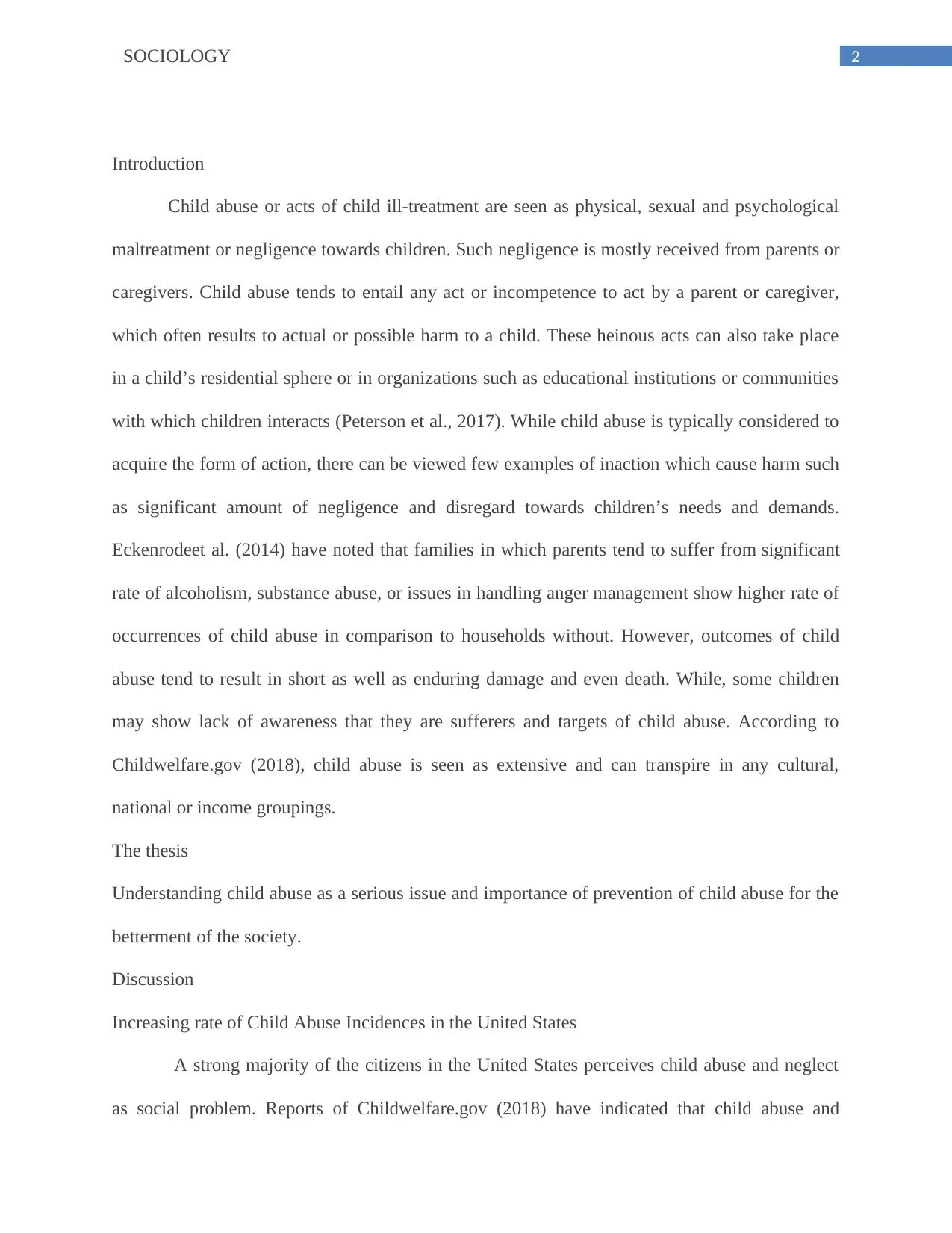
2SOCIOLOGY
Introduction
Child abuse or acts of child ill-treatment are seen as physical, sexual and psychological
maltreatment or negligence towards children. Such negligence is mostly received from parents or
caregivers. Child abuse tends to entail any act or incompetence to act by a parent or caregiver,
which often results to actual or possible harm to a child. These heinous acts can also take place
in a child’s residential sphere or in organizations such as educational institutions or communities
with which children interacts (Peterson et al., 2017). While child abuse is typically considered to
acquire the form of action, there can be viewed few examples of inaction which cause harm such
as significant amount of negligence and disregard towards children’s needs and demands.
Eckenrodeet al. (2014) have noted that families in which parents tend to suffer from significant
rate of alcoholism, substance abuse, or issues in handling anger management show higher rate of
occurrences of child abuse in comparison to households without. However, outcomes of child
abuse tend to result in short as well as enduring damage and even death. While, some children
may show lack of awareness that they are sufferers and targets of child abuse. According to
Childwelfare.gov (2018), child abuse is seen as extensive and can transpire in any cultural,
national or income groupings.
The thesis
Understanding child abuse as a serious issue and importance of prevention of child abuse for the
betterment of the society.
Discussion
Increasing rate of Child Abuse Incidences in the United States
A strong majority of the citizens in the United States perceives child abuse and neglect
as social problem. Reports of Childwelfare.gov (2018) have indicated that child abuse and
Introduction
Child abuse or acts of child ill-treatment are seen as physical, sexual and psychological
maltreatment or negligence towards children. Such negligence is mostly received from parents or
caregivers. Child abuse tends to entail any act or incompetence to act by a parent or caregiver,
which often results to actual or possible harm to a child. These heinous acts can also take place
in a child’s residential sphere or in organizations such as educational institutions or communities
with which children interacts (Peterson et al., 2017). While child abuse is typically considered to
acquire the form of action, there can be viewed few examples of inaction which cause harm such
as significant amount of negligence and disregard towards children’s needs and demands.
Eckenrodeet al. (2014) have noted that families in which parents tend to suffer from significant
rate of alcoholism, substance abuse, or issues in handling anger management show higher rate of
occurrences of child abuse in comparison to households without. However, outcomes of child
abuse tend to result in short as well as enduring damage and even death. While, some children
may show lack of awareness that they are sufferers and targets of child abuse. According to
Childwelfare.gov (2018), child abuse is seen as extensive and can transpire in any cultural,
national or income groupings.
The thesis
Understanding child abuse as a serious issue and importance of prevention of child abuse for the
betterment of the society.
Discussion
Increasing rate of Child Abuse Incidences in the United States
A strong majority of the citizens in the United States perceives child abuse and neglect
as social problem. Reports of Childwelfare.gov (2018) have indicated that child abuse and
⊘ This is a preview!⊘
Do you want full access?
Subscribe today to unlock all pages.

Trusted by 1+ million students worldwide
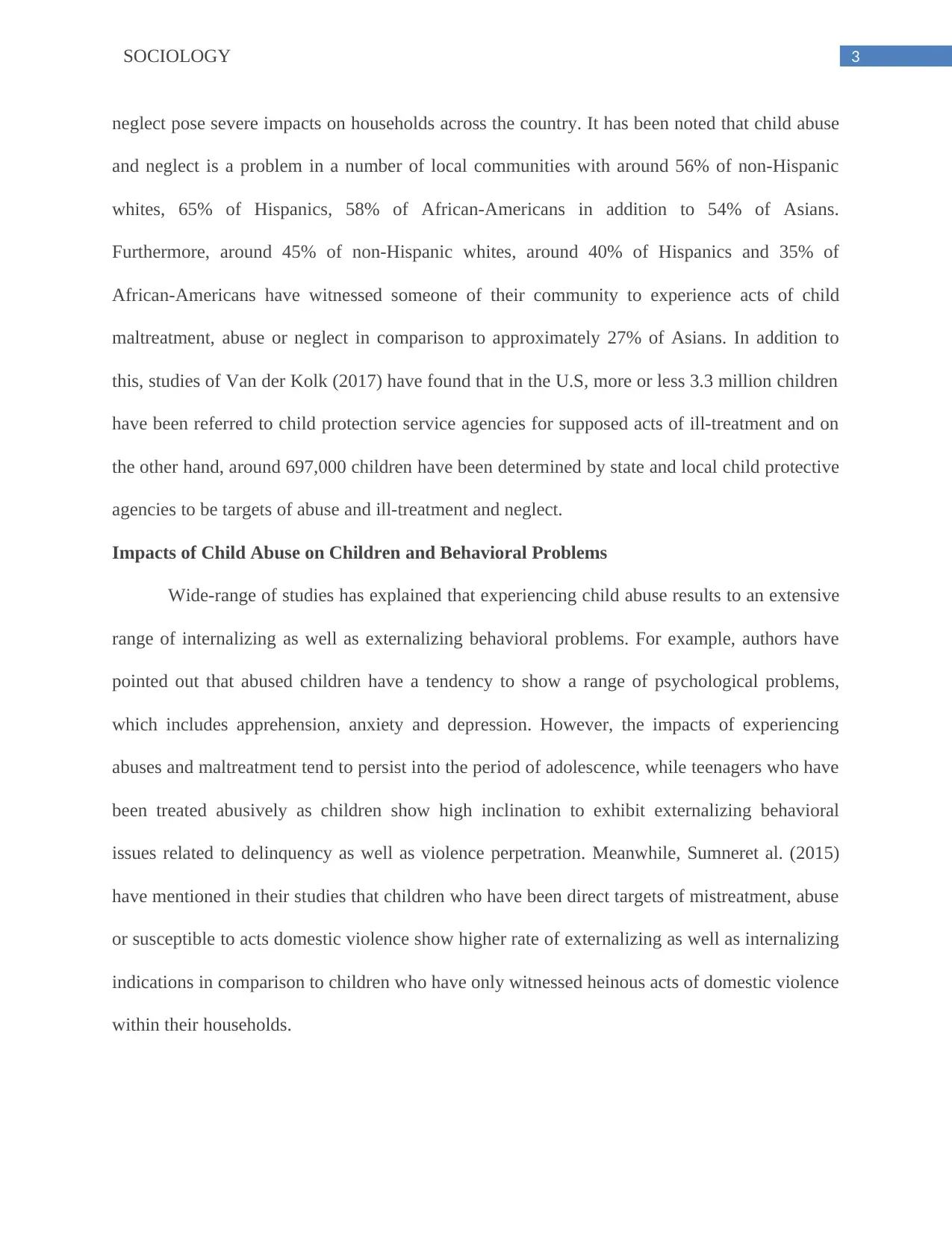
3SOCIOLOGY
neglect pose severe impacts on households across the country. It has been noted that child abuse
and neglect is a problem in a number of local communities with around 56% of non-Hispanic
whites, 65% of Hispanics, 58% of African-Americans in addition to 54% of Asians.
Furthermore, around 45% of non-Hispanic whites, around 40% of Hispanics and 35% of
African-Americans have witnessed someone of their community to experience acts of child
maltreatment, abuse or neglect in comparison to approximately 27% of Asians. In addition to
this, studies of Van der Kolk (2017) have found that in the U.S, more or less 3.3 million children
have been referred to child protection service agencies for supposed acts of ill-treatment and on
the other hand, around 697,000 children have been determined by state and local child protective
agencies to be targets of abuse and ill-treatment and neglect.
Impacts of Child Abuse on Children and Behavioral Problems
Wide-range of studies has explained that experiencing child abuse results to an extensive
range of internalizing as well as externalizing behavioral problems. For example, authors have
pointed out that abused children have a tendency to show a range of psychological problems,
which includes apprehension, anxiety and depression. However, the impacts of experiencing
abuses and maltreatment tend to persist into the period of adolescence, while teenagers who have
been treated abusively as children show high inclination to exhibit externalizing behavioral
issues related to delinquency as well as violence perpetration. Meanwhile, Sumneret al. (2015)
have mentioned in their studies that children who have been direct targets of mistreatment, abuse
or susceptible to acts domestic violence show higher rate of externalizing as well as internalizing
indications in comparison to children who have only witnessed heinous acts of domestic violence
within their households.
neglect pose severe impacts on households across the country. It has been noted that child abuse
and neglect is a problem in a number of local communities with around 56% of non-Hispanic
whites, 65% of Hispanics, 58% of African-Americans in addition to 54% of Asians.
Furthermore, around 45% of non-Hispanic whites, around 40% of Hispanics and 35% of
African-Americans have witnessed someone of their community to experience acts of child
maltreatment, abuse or neglect in comparison to approximately 27% of Asians. In addition to
this, studies of Van der Kolk (2017) have found that in the U.S, more or less 3.3 million children
have been referred to child protection service agencies for supposed acts of ill-treatment and on
the other hand, around 697,000 children have been determined by state and local child protective
agencies to be targets of abuse and ill-treatment and neglect.
Impacts of Child Abuse on Children and Behavioral Problems
Wide-range of studies has explained that experiencing child abuse results to an extensive
range of internalizing as well as externalizing behavioral problems. For example, authors have
pointed out that abused children have a tendency to show a range of psychological problems,
which includes apprehension, anxiety and depression. However, the impacts of experiencing
abuses and maltreatment tend to persist into the period of adolescence, while teenagers who have
been treated abusively as children show high inclination to exhibit externalizing behavioral
issues related to delinquency as well as violence perpetration. Meanwhile, Sumneret al. (2015)
have mentioned in their studies that children who have been direct targets of mistreatment, abuse
or susceptible to acts domestic violence show higher rate of externalizing as well as internalizing
indications in comparison to children who have only witnessed heinous acts of domestic violence
within their households.
Paraphrase This Document
Need a fresh take? Get an instant paraphrase of this document with our AI Paraphraser
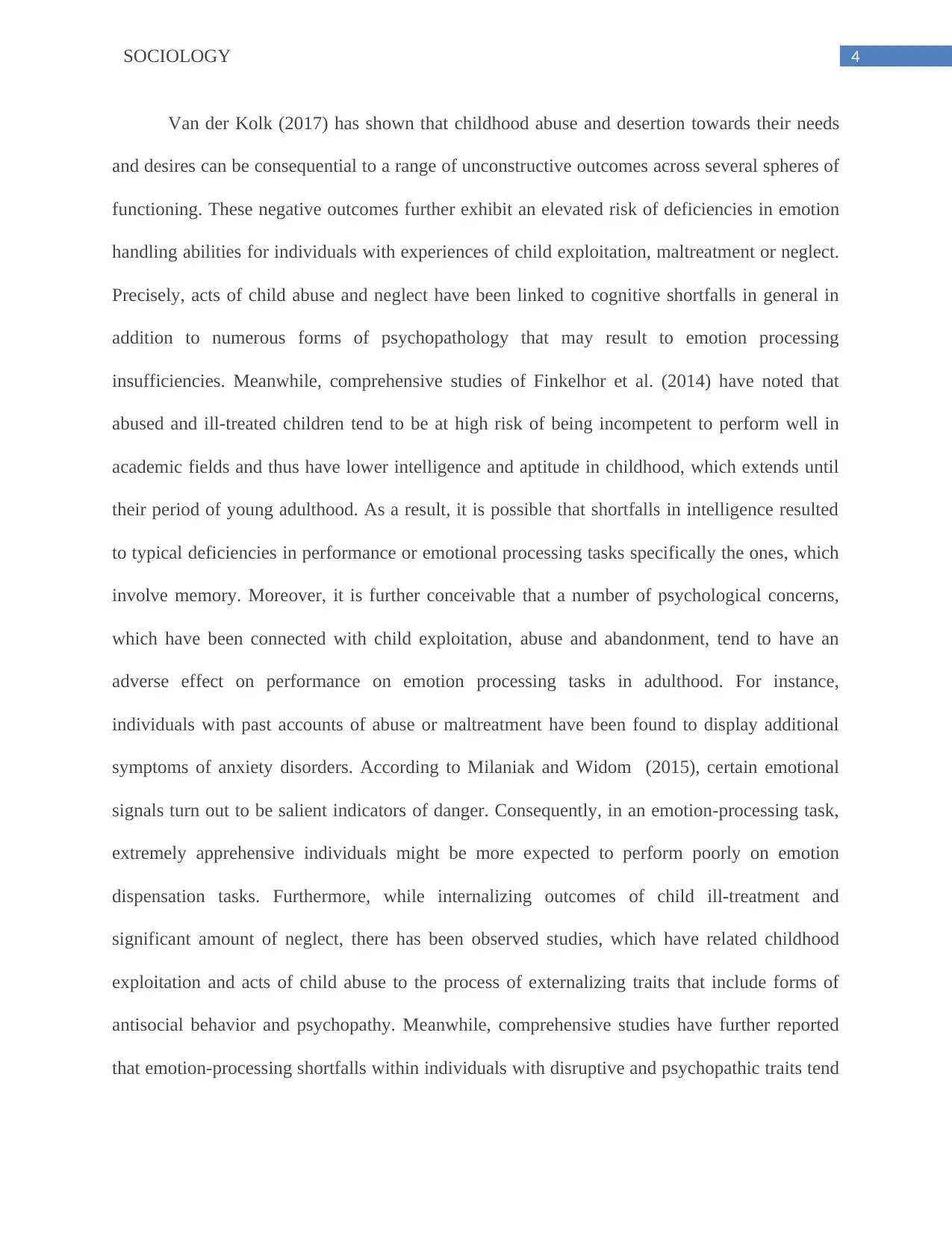
4SOCIOLOGY
Van der Kolk (2017) has shown that childhood abuse and desertion towards their needs
and desires can be consequential to a range of unconstructive outcomes across several spheres of
functioning. These negative outcomes further exhibit an elevated risk of deficiencies in emotion
handling abilities for individuals with experiences of child exploitation, maltreatment or neglect.
Precisely, acts of child abuse and neglect have been linked to cognitive shortfalls in general in
addition to numerous forms of psychopathology that may result to emotion processing
insufficiencies. Meanwhile, comprehensive studies of Finkelhor et al. (2014) have noted that
abused and ill-treated children tend to be at high risk of being incompetent to perform well in
academic fields and thus have lower intelligence and aptitude in childhood, which extends until
their period of young adulthood. As a result, it is possible that shortfalls in intelligence resulted
to typical deficiencies in performance or emotional processing tasks specifically the ones, which
involve memory. Moreover, it is further conceivable that a number of psychological concerns,
which have been connected with child exploitation, abuse and abandonment, tend to have an
adverse effect on performance on emotion processing tasks in adulthood. For instance,
individuals with past accounts of abuse or maltreatment have been found to display additional
symptoms of anxiety disorders. According to Milaniak and Widom (2015), certain emotional
signals turn out to be salient indicators of danger. Consequently, in an emotion-processing task,
extremely apprehensive individuals might be more expected to perform poorly on emotion
dispensation tasks. Furthermore, while internalizing outcomes of child ill-treatment and
significant amount of neglect, there has been observed studies, which have related childhood
exploitation and acts of child abuse to the process of externalizing traits that include forms of
antisocial behavior and psychopathy. Meanwhile, comprehensive studies have further reported
that emotion-processing shortfalls within individuals with disruptive and psychopathic traits tend
Van der Kolk (2017) has shown that childhood abuse and desertion towards their needs
and desires can be consequential to a range of unconstructive outcomes across several spheres of
functioning. These negative outcomes further exhibit an elevated risk of deficiencies in emotion
handling abilities for individuals with experiences of child exploitation, maltreatment or neglect.
Precisely, acts of child abuse and neglect have been linked to cognitive shortfalls in general in
addition to numerous forms of psychopathology that may result to emotion processing
insufficiencies. Meanwhile, comprehensive studies of Finkelhor et al. (2014) have noted that
abused and ill-treated children tend to be at high risk of being incompetent to perform well in
academic fields and thus have lower intelligence and aptitude in childhood, which extends until
their period of young adulthood. As a result, it is possible that shortfalls in intelligence resulted
to typical deficiencies in performance or emotional processing tasks specifically the ones, which
involve memory. Moreover, it is further conceivable that a number of psychological concerns,
which have been connected with child exploitation, abuse and abandonment, tend to have an
adverse effect on performance on emotion processing tasks in adulthood. For instance,
individuals with past accounts of abuse or maltreatment have been found to display additional
symptoms of anxiety disorders. According to Milaniak and Widom (2015), certain emotional
signals turn out to be salient indicators of danger. Consequently, in an emotion-processing task,
extremely apprehensive individuals might be more expected to perform poorly on emotion
dispensation tasks. Furthermore, while internalizing outcomes of child ill-treatment and
significant amount of neglect, there has been observed studies, which have related childhood
exploitation and acts of child abuse to the process of externalizing traits that include forms of
antisocial behavior and psychopathy. Meanwhile, comprehensive studies have further reported
that emotion-processing shortfalls within individuals with disruptive and psychopathic traits tend
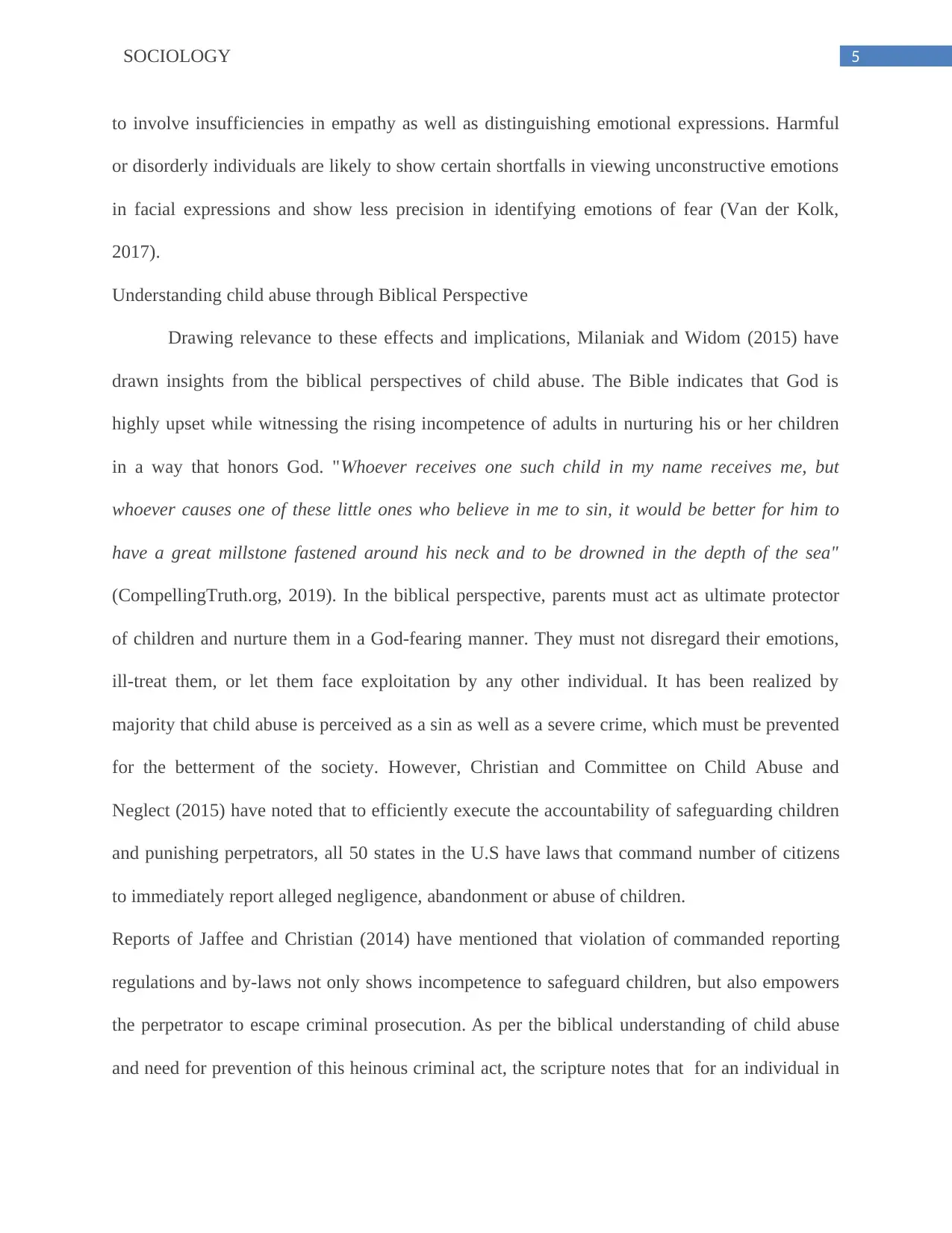
5SOCIOLOGY
to involve insufficiencies in empathy as well as distinguishing emotional expressions. Harmful
or disorderly individuals are likely to show certain shortfalls in viewing unconstructive emotions
in facial expressions and show less precision in identifying emotions of fear (Van der Kolk,
2017).
Understanding child abuse through Biblical Perspective
Drawing relevance to these effects and implications, Milaniak and Widom (2015) have
drawn insights from the biblical perspectives of child abuse. The Bible indicates that God is
highly upset while witnessing the rising incompetence of adults in nurturing his or her children
in a way that honors God. "Whoever receives one such child in my name receives me, but
whoever causes one of these little ones who believe in me to sin, it would be better for him to
have a great millstone fastened around his neck and to be drowned in the depth of the sea"
(CompellingTruth.org, 2019). In the biblical perspective, parents must act as ultimate protector
of children and nurture them in a God-fearing manner. They must not disregard their emotions,
ill-treat them, or let them face exploitation by any other individual. It has been realized by
majority that child abuse is perceived as a sin as well as a severe crime, which must be prevented
for the betterment of the society. However, Christian and Committee on Child Abuse and
Neglect (2015) have noted that to efficiently execute the accountability of safeguarding children
and punishing perpetrators, all 50 states in the U.S have laws that command number of citizens
to immediately report alleged negligence, abandonment or abuse of children.
Reports of Jaffee and Christian (2014) have mentioned that violation of commanded reporting
regulations and by-laws not only shows incompetence to safeguard children, but also empowers
the perpetrator to escape criminal prosecution. As per the biblical understanding of child abuse
and need for prevention of this heinous criminal act, the scripture notes that for an individual in
to involve insufficiencies in empathy as well as distinguishing emotional expressions. Harmful
or disorderly individuals are likely to show certain shortfalls in viewing unconstructive emotions
in facial expressions and show less precision in identifying emotions of fear (Van der Kolk,
2017).
Understanding child abuse through Biblical Perspective
Drawing relevance to these effects and implications, Milaniak and Widom (2015) have
drawn insights from the biblical perspectives of child abuse. The Bible indicates that God is
highly upset while witnessing the rising incompetence of adults in nurturing his or her children
in a way that honors God. "Whoever receives one such child in my name receives me, but
whoever causes one of these little ones who believe in me to sin, it would be better for him to
have a great millstone fastened around his neck and to be drowned in the depth of the sea"
(CompellingTruth.org, 2019). In the biblical perspective, parents must act as ultimate protector
of children and nurture them in a God-fearing manner. They must not disregard their emotions,
ill-treat them, or let them face exploitation by any other individual. It has been realized by
majority that child abuse is perceived as a sin as well as a severe crime, which must be prevented
for the betterment of the society. However, Christian and Committee on Child Abuse and
Neglect (2015) have noted that to efficiently execute the accountability of safeguarding children
and punishing perpetrators, all 50 states in the U.S have laws that command number of citizens
to immediately report alleged negligence, abandonment or abuse of children.
Reports of Jaffee and Christian (2014) have mentioned that violation of commanded reporting
regulations and by-laws not only shows incompetence to safeguard children, but also empowers
the perpetrator to escape criminal prosecution. As per the biblical understanding of child abuse
and need for prevention of this heinous criminal act, the scripture notes that for an individual in
⊘ This is a preview!⊘
Do you want full access?
Subscribe today to unlock all pages.

Trusted by 1+ million students worldwide
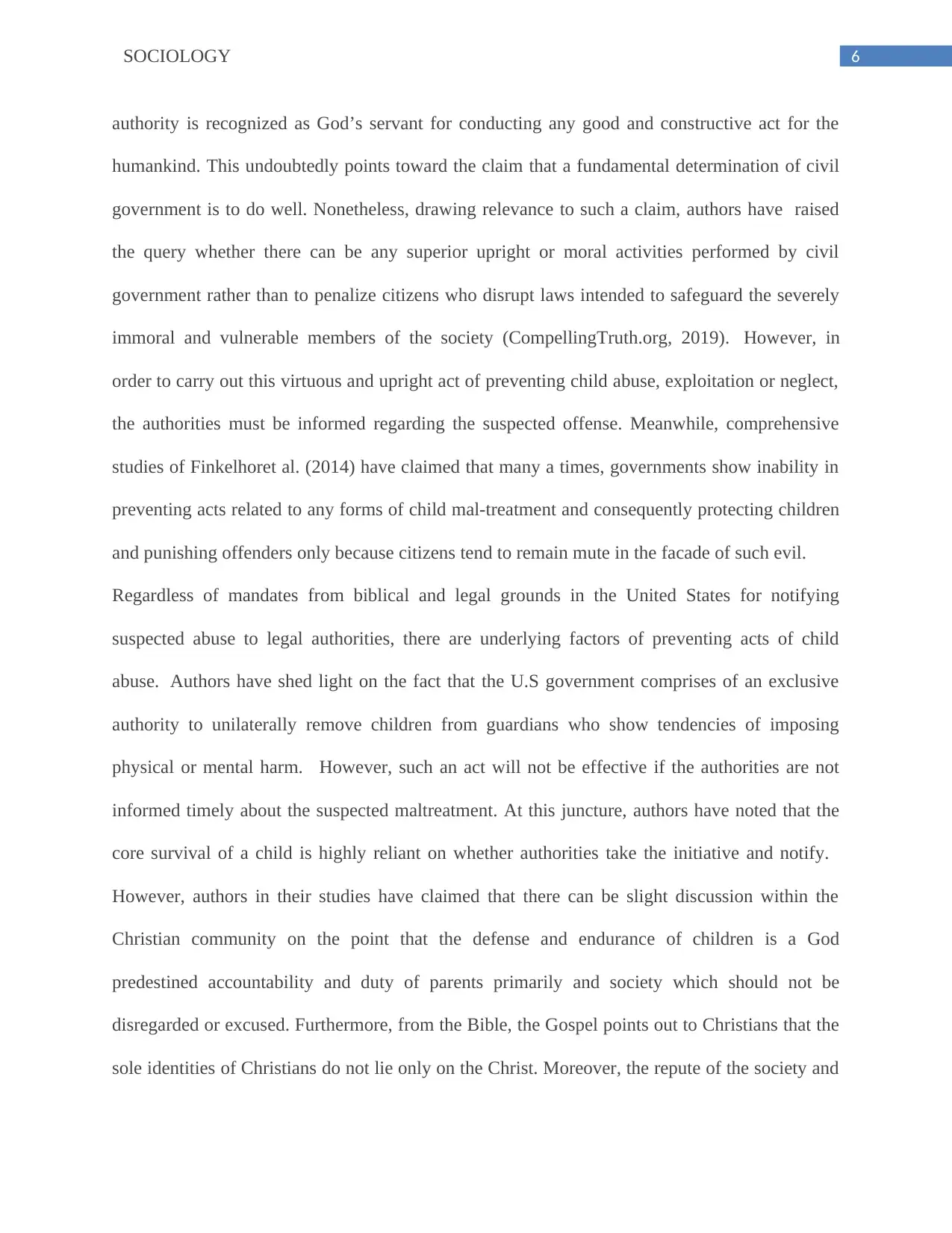
6SOCIOLOGY
authority is recognized as God’s servant for conducting any good and constructive act for the
humankind. This undoubtedly points toward the claim that a fundamental determination of civil
government is to do well. Nonetheless, drawing relevance to such a claim, authors have raised
the query whether there can be any superior upright or moral activities performed by civil
government rather than to penalize citizens who disrupt laws intended to safeguard the severely
immoral and vulnerable members of the society (CompellingTruth.org, 2019). However, in
order to carry out this virtuous and upright act of preventing child abuse, exploitation or neglect,
the authorities must be informed regarding the suspected offense. Meanwhile, comprehensive
studies of Finkelhoret al. (2014) have claimed that many a times, governments show inability in
preventing acts related to any forms of child mal-treatment and consequently protecting children
and punishing offenders only because citizens tend to remain mute in the facade of such evil.
Regardless of mandates from biblical and legal grounds in the United States for notifying
suspected abuse to legal authorities, there are underlying factors of preventing acts of child
abuse. Authors have shed light on the fact that the U.S government comprises of an exclusive
authority to unilaterally remove children from guardians who show tendencies of imposing
physical or mental harm. However, such an act will not be effective if the authorities are not
informed timely about the suspected maltreatment. At this juncture, authors have noted that the
core survival of a child is highly reliant on whether authorities take the initiative and notify.
However, authors in their studies have claimed that there can be slight discussion within the
Christian community on the point that the defense and endurance of children is a God
predestined accountability and duty of parents primarily and society which should not be
disregarded or excused. Furthermore, from the Bible, the Gospel points out to Christians that the
sole identities of Christians do not lie only on the Christ. Moreover, the repute of the society and
authority is recognized as God’s servant for conducting any good and constructive act for the
humankind. This undoubtedly points toward the claim that a fundamental determination of civil
government is to do well. Nonetheless, drawing relevance to such a claim, authors have raised
the query whether there can be any superior upright or moral activities performed by civil
government rather than to penalize citizens who disrupt laws intended to safeguard the severely
immoral and vulnerable members of the society (CompellingTruth.org, 2019). However, in
order to carry out this virtuous and upright act of preventing child abuse, exploitation or neglect,
the authorities must be informed regarding the suspected offense. Meanwhile, comprehensive
studies of Finkelhoret al. (2014) have claimed that many a times, governments show inability in
preventing acts related to any forms of child mal-treatment and consequently protecting children
and punishing offenders only because citizens tend to remain mute in the facade of such evil.
Regardless of mandates from biblical and legal grounds in the United States for notifying
suspected abuse to legal authorities, there are underlying factors of preventing acts of child
abuse. Authors have shed light on the fact that the U.S government comprises of an exclusive
authority to unilaterally remove children from guardians who show tendencies of imposing
physical or mental harm. However, such an act will not be effective if the authorities are not
informed timely about the suspected maltreatment. At this juncture, authors have noted that the
core survival of a child is highly reliant on whether authorities take the initiative and notify.
However, authors in their studies have claimed that there can be slight discussion within the
Christian community on the point that the defense and endurance of children is a God
predestined accountability and duty of parents primarily and society which should not be
disregarded or excused. Furthermore, from the Bible, the Gospel points out to Christians that the
sole identities of Christians do not lie only on the Christ. Moreover, the repute of the society and
Paraphrase This Document
Need a fresh take? Get an instant paraphrase of this document with our AI Paraphraser
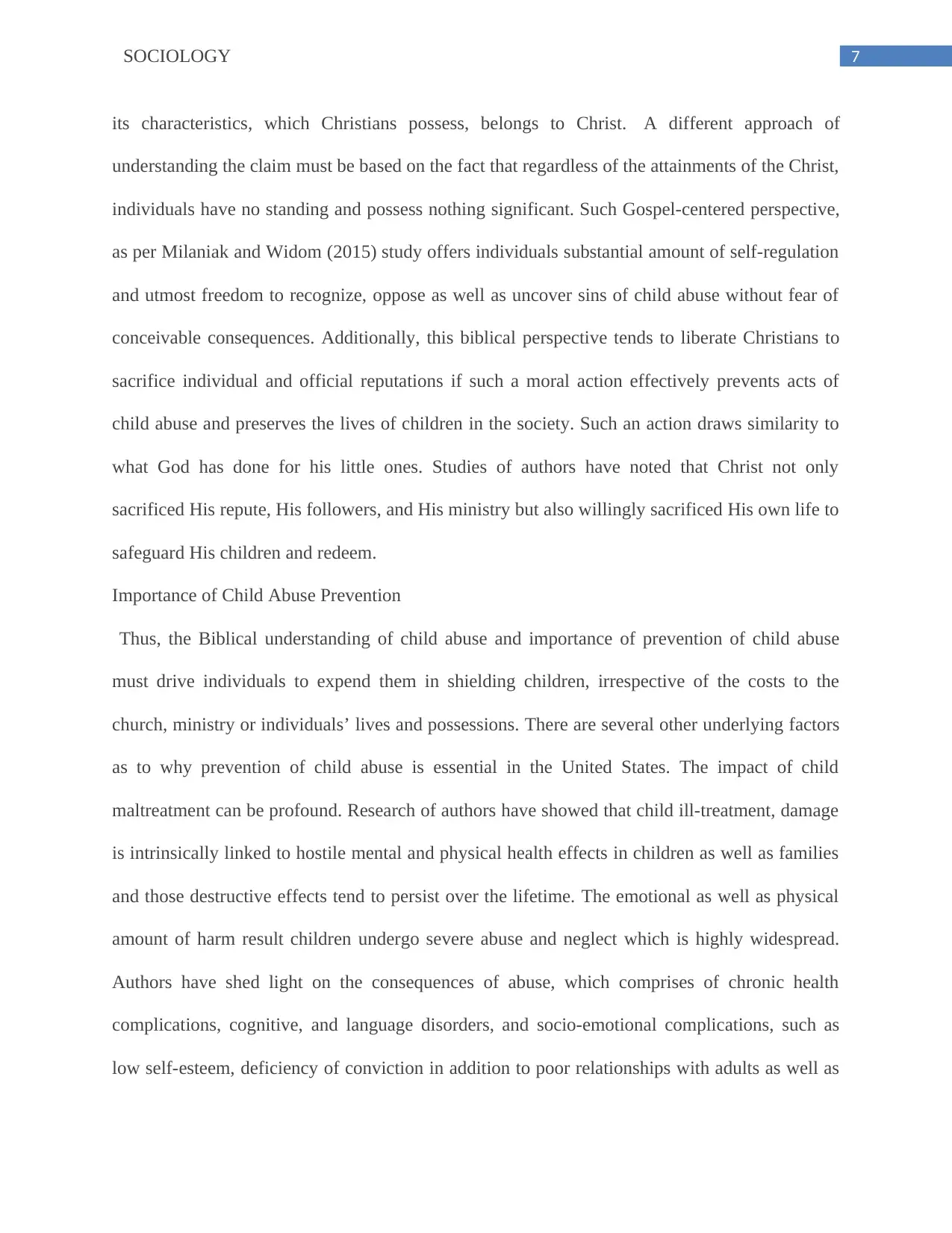
7SOCIOLOGY
its characteristics, which Christians possess, belongs to Christ. A different approach of
understanding the claim must be based on the fact that regardless of the attainments of the Christ,
individuals have no standing and possess nothing significant. Such Gospel-centered perspective,
as per Milaniak and Widom (2015) study offers individuals substantial amount of self-regulation
and utmost freedom to recognize, oppose as well as uncover sins of child abuse without fear of
conceivable consequences. Additionally, this biblical perspective tends to liberate Christians to
sacrifice individual and official reputations if such a moral action effectively prevents acts of
child abuse and preserves the lives of children in the society. Such an action draws similarity to
what God has done for his little ones. Studies of authors have noted that Christ not only
sacrificed His repute, His followers, and His ministry but also willingly sacrificed His own life to
safeguard His children and redeem.
Importance of Child Abuse Prevention
Thus, the Biblical understanding of child abuse and importance of prevention of child abuse
must drive individuals to expend them in shielding children, irrespective of the costs to the
church, ministry or individuals’ lives and possessions. There are several other underlying factors
as to why prevention of child abuse is essential in the United States. The impact of child
maltreatment can be profound. Research of authors have showed that child ill-treatment, damage
is intrinsically linked to hostile mental and physical health effects in children as well as families
and those destructive effects tend to persist over the lifetime. The emotional as well as physical
amount of harm result children undergo severe abuse and neglect which is highly widespread.
Authors have shed light on the consequences of abuse, which comprises of chronic health
complications, cognitive, and language disorders, and socio-emotional complications, such as
low self-esteem, deficiency of conviction in addition to poor relationships with adults as well as
its characteristics, which Christians possess, belongs to Christ. A different approach of
understanding the claim must be based on the fact that regardless of the attainments of the Christ,
individuals have no standing and possess nothing significant. Such Gospel-centered perspective,
as per Milaniak and Widom (2015) study offers individuals substantial amount of self-regulation
and utmost freedom to recognize, oppose as well as uncover sins of child abuse without fear of
conceivable consequences. Additionally, this biblical perspective tends to liberate Christians to
sacrifice individual and official reputations if such a moral action effectively prevents acts of
child abuse and preserves the lives of children in the society. Such an action draws similarity to
what God has done for his little ones. Studies of authors have noted that Christ not only
sacrificed His repute, His followers, and His ministry but also willingly sacrificed His own life to
safeguard His children and redeem.
Importance of Child Abuse Prevention
Thus, the Biblical understanding of child abuse and importance of prevention of child abuse
must drive individuals to expend them in shielding children, irrespective of the costs to the
church, ministry or individuals’ lives and possessions. There are several other underlying factors
as to why prevention of child abuse is essential in the United States. The impact of child
maltreatment can be profound. Research of authors have showed that child ill-treatment, damage
is intrinsically linked to hostile mental and physical health effects in children as well as families
and those destructive effects tend to persist over the lifetime. The emotional as well as physical
amount of harm result children undergo severe abuse and neglect which is highly widespread.
Authors have shed light on the consequences of abuse, which comprises of chronic health
complications, cognitive, and language disorders, and socio-emotional complications, such as
low self-esteem, deficiency of conviction in addition to poor relationships with adults as well as
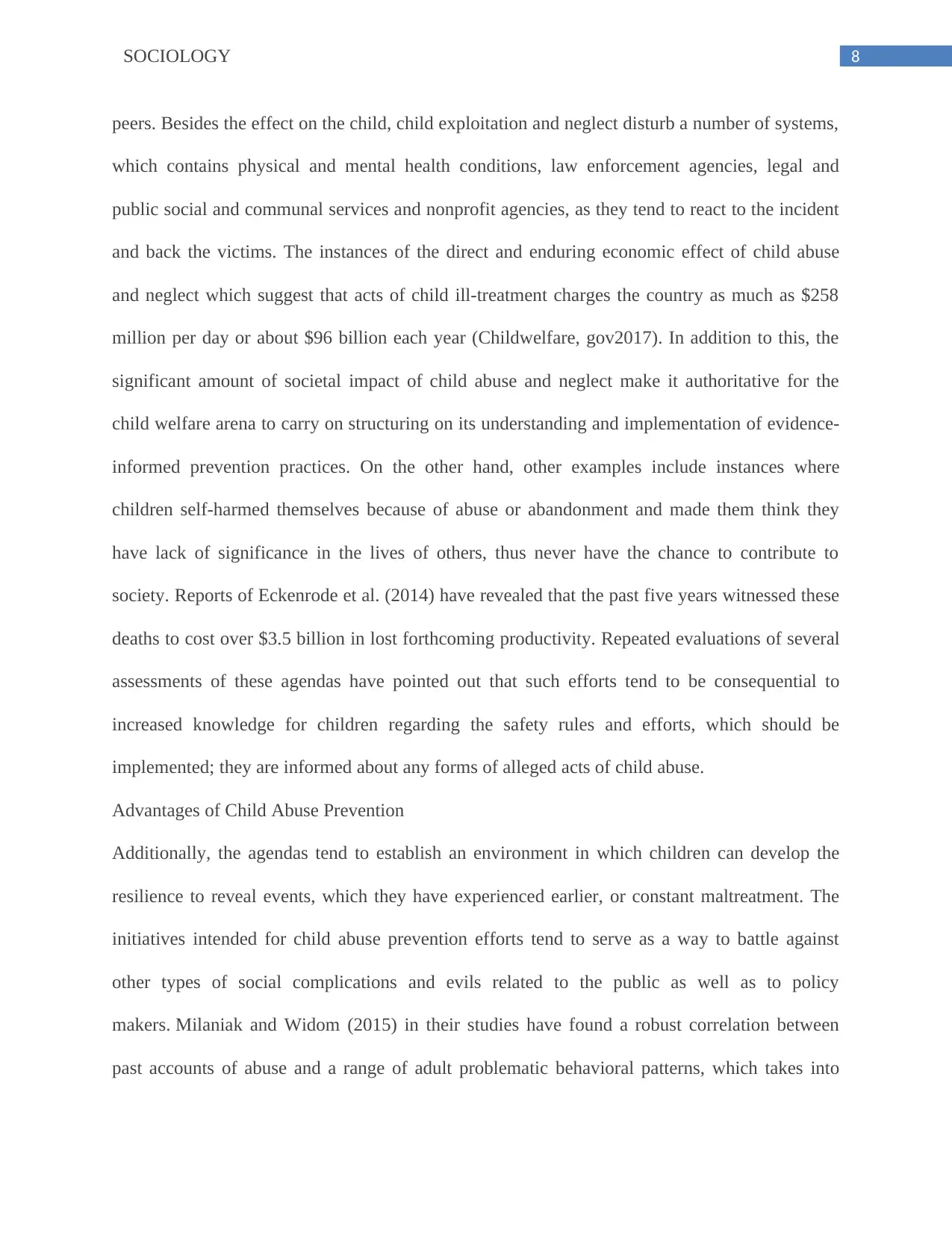
8SOCIOLOGY
peers. Besides the effect on the child, child exploitation and neglect disturb a number of systems,
which contains physical and mental health conditions, law enforcement agencies, legal and
public social and communal services and nonprofit agencies, as they tend to react to the incident
and back the victims. The instances of the direct and enduring economic effect of child abuse
and neglect which suggest that acts of child ill-treatment charges the country as much as $258
million per day or about $96 billion each year (Childwelfare, gov2017). In addition to this, the
significant amount of societal impact of child abuse and neglect make it authoritative for the
child welfare arena to carry on structuring on its understanding and implementation of evidence-
informed prevention practices. On the other hand, other examples include instances where
children self-harmed themselves because of abuse or abandonment and made them think they
have lack of significance in the lives of others, thus never have the chance to contribute to
society. Reports of Eckenrode et al. (2014) have revealed that the past five years witnessed these
deaths to cost over $3.5 billion in lost forthcoming productivity. Repeated evaluations of several
assessments of these agendas have pointed out that such efforts tend to be consequential to
increased knowledge for children regarding the safety rules and efforts, which should be
implemented; they are informed about any forms of alleged acts of child abuse.
Advantages of Child Abuse Prevention
Additionally, the agendas tend to establish an environment in which children can develop the
resilience to reveal events, which they have experienced earlier, or constant maltreatment. The
initiatives intended for child abuse prevention efforts tend to serve as a way to battle against
other types of social complications and evils related to the public as well as to policy
makers. Milaniak and Widom (2015) in their studies have found a robust correlation between
past accounts of abuse and a range of adult problematic behavioral patterns, which takes into
peers. Besides the effect on the child, child exploitation and neglect disturb a number of systems,
which contains physical and mental health conditions, law enforcement agencies, legal and
public social and communal services and nonprofit agencies, as they tend to react to the incident
and back the victims. The instances of the direct and enduring economic effect of child abuse
and neglect which suggest that acts of child ill-treatment charges the country as much as $258
million per day or about $96 billion each year (Childwelfare, gov2017). In addition to this, the
significant amount of societal impact of child abuse and neglect make it authoritative for the
child welfare arena to carry on structuring on its understanding and implementation of evidence-
informed prevention practices. On the other hand, other examples include instances where
children self-harmed themselves because of abuse or abandonment and made them think they
have lack of significance in the lives of others, thus never have the chance to contribute to
society. Reports of Eckenrode et al. (2014) have revealed that the past five years witnessed these
deaths to cost over $3.5 billion in lost forthcoming productivity. Repeated evaluations of several
assessments of these agendas have pointed out that such efforts tend to be consequential to
increased knowledge for children regarding the safety rules and efforts, which should be
implemented; they are informed about any forms of alleged acts of child abuse.
Advantages of Child Abuse Prevention
Additionally, the agendas tend to establish an environment in which children can develop the
resilience to reveal events, which they have experienced earlier, or constant maltreatment. The
initiatives intended for child abuse prevention efforts tend to serve as a way to battle against
other types of social complications and evils related to the public as well as to policy
makers. Milaniak and Widom (2015) in their studies have found a robust correlation between
past accounts of abuse and a range of adult problematic behavioral patterns, which takes into
⊘ This is a preview!⊘
Do you want full access?
Subscribe today to unlock all pages.

Trusted by 1+ million students worldwide
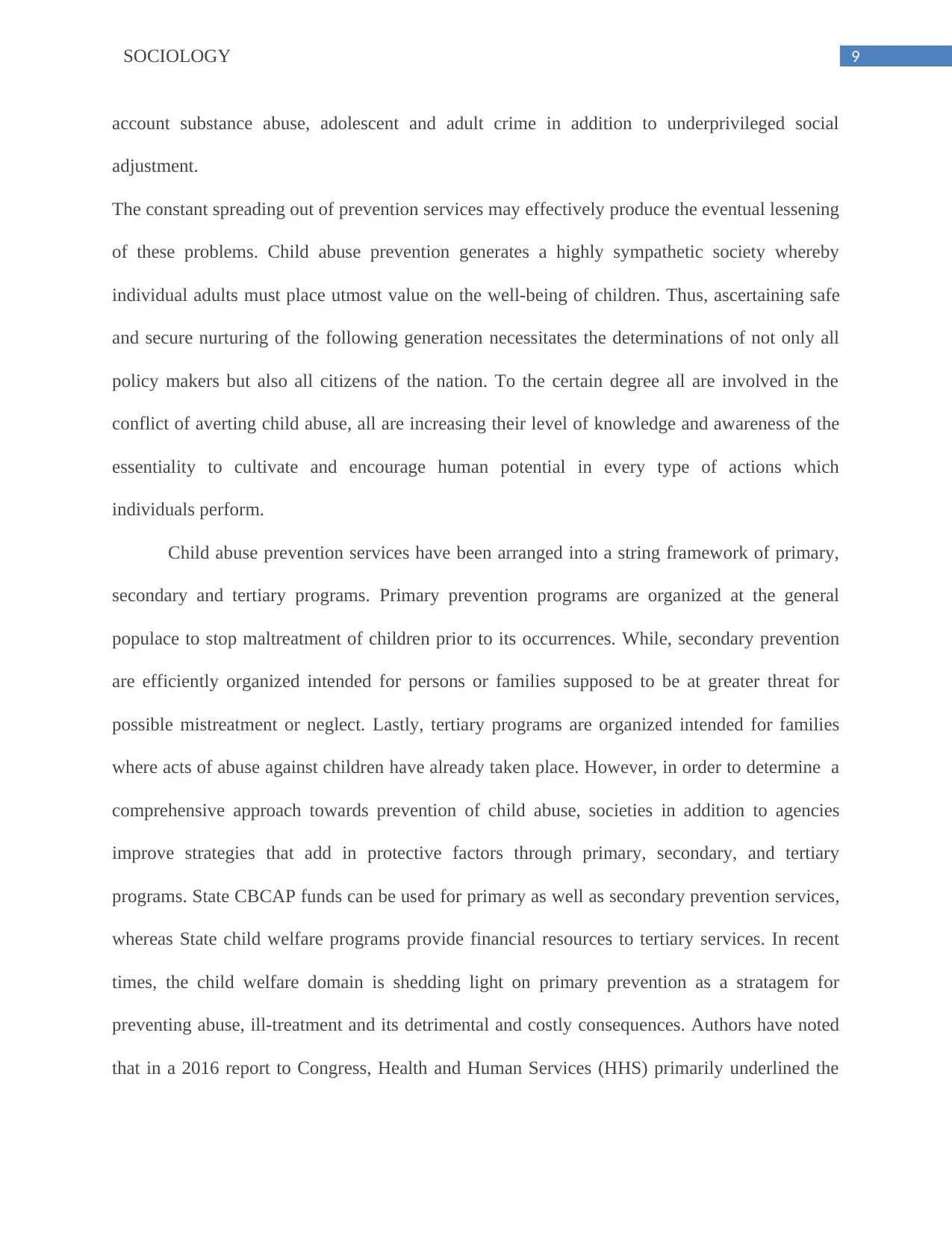
9SOCIOLOGY
account substance abuse, adolescent and adult crime in addition to underprivileged social
adjustment.
The constant spreading out of prevention services may effectively produce the eventual lessening
of these problems. Child abuse prevention generates a highly sympathetic society whereby
individual adults must place utmost value on the well-being of children. Thus, ascertaining safe
and secure nurturing of the following generation necessitates the determinations of not only all
policy makers but also all citizens of the nation. To the certain degree all are involved in the
conflict of averting child abuse, all are increasing their level of knowledge and awareness of the
essentiality to cultivate and encourage human potential in every type of actions which
individuals perform.
Child abuse prevention services have been arranged into a string framework of primary,
secondary and tertiary programs. Primary prevention programs are organized at the general
populace to stop maltreatment of children prior to its occurrences. While, secondary prevention
are efficiently organized intended for persons or families supposed to be at greater threat for
possible mistreatment or neglect. Lastly, tertiary programs are organized intended for families
where acts of abuse against children have already taken place. However, in order to determine a
comprehensive approach towards prevention of child abuse, societies in addition to agencies
improve strategies that add in protective factors through primary, secondary, and tertiary
programs. State CBCAP funds can be used for primary as well as secondary prevention services,
whereas State child welfare programs provide financial resources to tertiary services. In recent
times, the child welfare domain is shedding light on primary prevention as a stratagem for
preventing abuse, ill-treatment and its detrimental and costly consequences. Authors have noted
that in a 2016 report to Congress, Health and Human Services (HHS) primarily underlined the
account substance abuse, adolescent and adult crime in addition to underprivileged social
adjustment.
The constant spreading out of prevention services may effectively produce the eventual lessening
of these problems. Child abuse prevention generates a highly sympathetic society whereby
individual adults must place utmost value on the well-being of children. Thus, ascertaining safe
and secure nurturing of the following generation necessitates the determinations of not only all
policy makers but also all citizens of the nation. To the certain degree all are involved in the
conflict of averting child abuse, all are increasing their level of knowledge and awareness of the
essentiality to cultivate and encourage human potential in every type of actions which
individuals perform.
Child abuse prevention services have been arranged into a string framework of primary,
secondary and tertiary programs. Primary prevention programs are organized at the general
populace to stop maltreatment of children prior to its occurrences. While, secondary prevention
are efficiently organized intended for persons or families supposed to be at greater threat for
possible mistreatment or neglect. Lastly, tertiary programs are organized intended for families
where acts of abuse against children have already taken place. However, in order to determine a
comprehensive approach towards prevention of child abuse, societies in addition to agencies
improve strategies that add in protective factors through primary, secondary, and tertiary
programs. State CBCAP funds can be used for primary as well as secondary prevention services,
whereas State child welfare programs provide financial resources to tertiary services. In recent
times, the child welfare domain is shedding light on primary prevention as a stratagem for
preventing abuse, ill-treatment and its detrimental and costly consequences. Authors have noted
that in a 2016 report to Congress, Health and Human Services (HHS) primarily underlined the
Paraphrase This Document
Need a fresh take? Get an instant paraphrase of this document with our AI Paraphraser
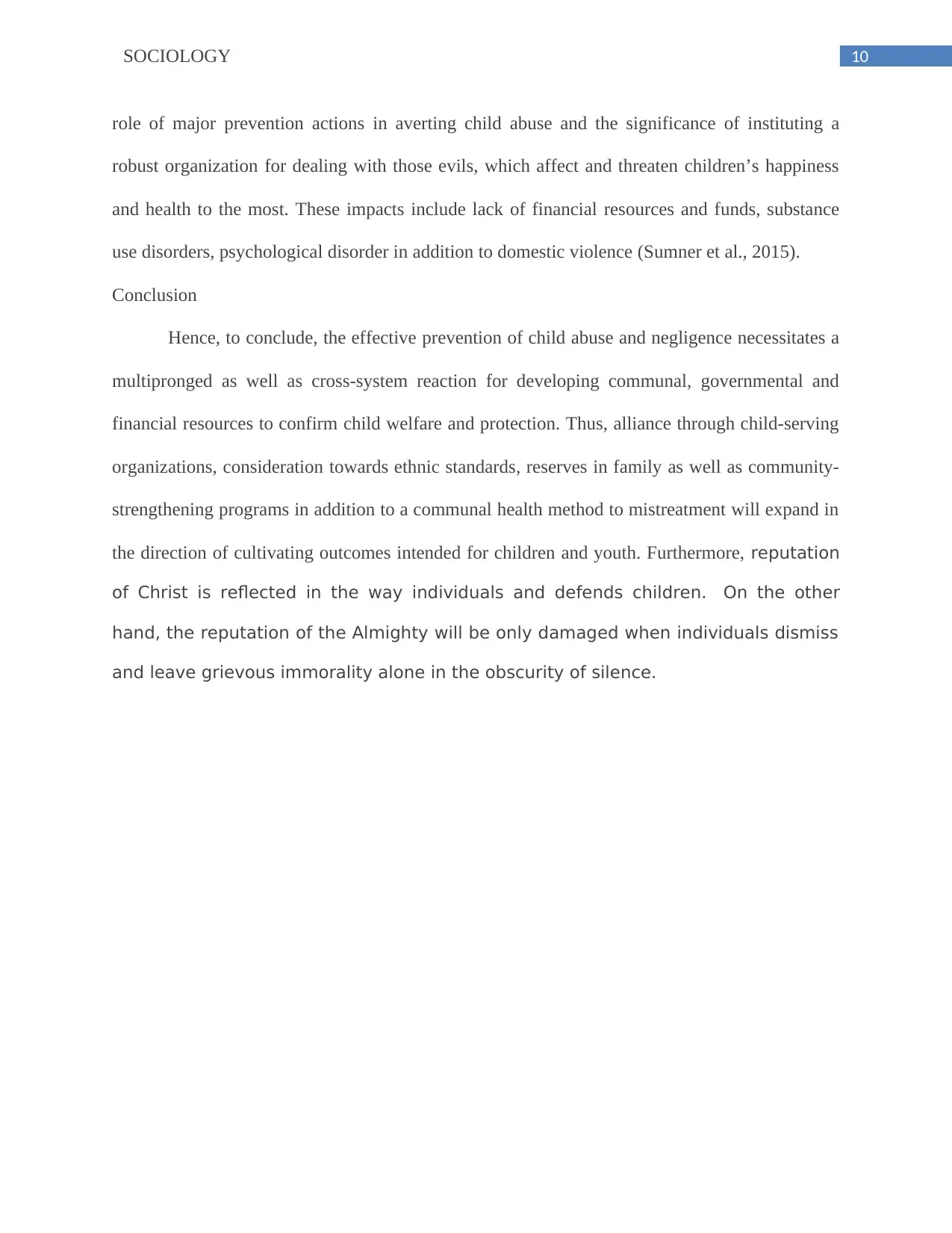
10SOCIOLOGY
role of major prevention actions in averting child abuse and the significance of instituting a
robust organization for dealing with those evils, which affect and threaten children’s happiness
and health to the most. These impacts include lack of financial resources and funds, substance
use disorders, psychological disorder in addition to domestic violence (Sumner et al., 2015).
Conclusion
Hence, to conclude, the effective prevention of child abuse and negligence necessitates a
multipronged as well as cross-system reaction for developing communal, governmental and
financial resources to confirm child welfare and protection. Thus, alliance through child-serving
organizations, consideration towards ethnic standards, reserves in family as well as community-
strengthening programs in addition to a communal health method to mistreatment will expand in
the direction of cultivating outcomes intended for children and youth. Furthermore, reputation
of Christ is reflected in the way individuals and defends children. On the other
hand, the reputation of the Almighty will be only damaged when individuals dismiss
and leave grievous immorality alone in the obscurity of silence.
role of major prevention actions in averting child abuse and the significance of instituting a
robust organization for dealing with those evils, which affect and threaten children’s happiness
and health to the most. These impacts include lack of financial resources and funds, substance
use disorders, psychological disorder in addition to domestic violence (Sumner et al., 2015).
Conclusion
Hence, to conclude, the effective prevention of child abuse and negligence necessitates a
multipronged as well as cross-system reaction for developing communal, governmental and
financial resources to confirm child welfare and protection. Thus, alliance through child-serving
organizations, consideration towards ethnic standards, reserves in family as well as community-
strengthening programs in addition to a communal health method to mistreatment will expand in
the direction of cultivating outcomes intended for children and youth. Furthermore, reputation
of Christ is reflected in the way individuals and defends children. On the other
hand, the reputation of the Almighty will be only damaged when individuals dismiss
and leave grievous immorality alone in the obscurity of silence.
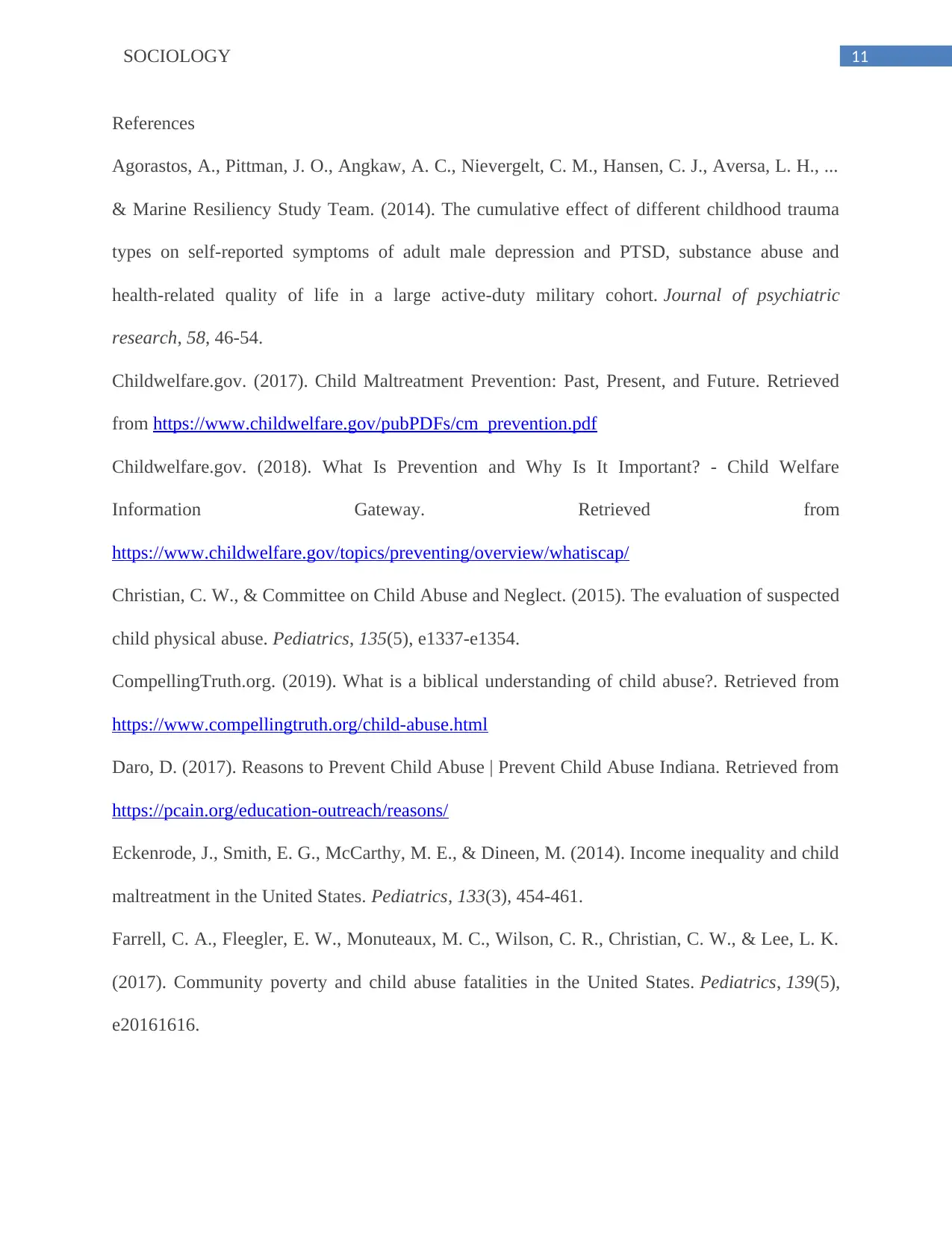
11SOCIOLOGY
References
Agorastos, A., Pittman, J. O., Angkaw, A. C., Nievergelt, C. M., Hansen, C. J., Aversa, L. H., ...
& Marine Resiliency Study Team. (2014). The cumulative effect of different childhood trauma
types on self-reported symptoms of adult male depression and PTSD, substance abuse and
health-related quality of life in a large active-duty military cohort. Journal of psychiatric
research, 58, 46-54.
Childwelfare.gov. (2017). Child Maltreatment Prevention: Past, Present, and Future. Retrieved
from https://www.childwelfare.gov/pubPDFs/cm_prevention.pdf
Childwelfare.gov. (2018). What Is Prevention and Why Is It Important? - Child Welfare
Information Gateway. Retrieved from
https://www.childwelfare.gov/topics/preventing/overview/whatiscap/
Christian, C. W., & Committee on Child Abuse and Neglect. (2015). The evaluation of suspected
child physical abuse. Pediatrics, 135(5), e1337-e1354.
CompellingTruth.org. (2019). What is a biblical understanding of child abuse?. Retrieved from
https://www.compellingtruth.org/child-abuse.html
Daro, D. (2017). Reasons to Prevent Child Abuse | Prevent Child Abuse Indiana. Retrieved from
https://pcain.org/education-outreach/reasons/
Eckenrode, J., Smith, E. G., McCarthy, M. E., & Dineen, M. (2014). Income inequality and child
maltreatment in the United States. Pediatrics, 133(3), 454-461.
Farrell, C. A., Fleegler, E. W., Monuteaux, M. C., Wilson, C. R., Christian, C. W., & Lee, L. K.
(2017). Community poverty and child abuse fatalities in the United States. Pediatrics, 139(5),
e20161616.
References
Agorastos, A., Pittman, J. O., Angkaw, A. C., Nievergelt, C. M., Hansen, C. J., Aversa, L. H., ...
& Marine Resiliency Study Team. (2014). The cumulative effect of different childhood trauma
types on self-reported symptoms of adult male depression and PTSD, substance abuse and
health-related quality of life in a large active-duty military cohort. Journal of psychiatric
research, 58, 46-54.
Childwelfare.gov. (2017). Child Maltreatment Prevention: Past, Present, and Future. Retrieved
from https://www.childwelfare.gov/pubPDFs/cm_prevention.pdf
Childwelfare.gov. (2018). What Is Prevention and Why Is It Important? - Child Welfare
Information Gateway. Retrieved from
https://www.childwelfare.gov/topics/preventing/overview/whatiscap/
Christian, C. W., & Committee on Child Abuse and Neglect. (2015). The evaluation of suspected
child physical abuse. Pediatrics, 135(5), e1337-e1354.
CompellingTruth.org. (2019). What is a biblical understanding of child abuse?. Retrieved from
https://www.compellingtruth.org/child-abuse.html
Daro, D. (2017). Reasons to Prevent Child Abuse | Prevent Child Abuse Indiana. Retrieved from
https://pcain.org/education-outreach/reasons/
Eckenrode, J., Smith, E. G., McCarthy, M. E., & Dineen, M. (2014). Income inequality and child
maltreatment in the United States. Pediatrics, 133(3), 454-461.
Farrell, C. A., Fleegler, E. W., Monuteaux, M. C., Wilson, C. R., Christian, C. W., & Lee, L. K.
(2017). Community poverty and child abuse fatalities in the United States. Pediatrics, 139(5),
e20161616.
⊘ This is a preview!⊘
Do you want full access?
Subscribe today to unlock all pages.

Trusted by 1+ million students worldwide
1 out of 14
Related Documents
Your All-in-One AI-Powered Toolkit for Academic Success.
+13062052269
info@desklib.com
Available 24*7 on WhatsApp / Email
![[object Object]](/_next/static/media/star-bottom.7253800d.svg)
Unlock your academic potential
Copyright © 2020–2025 A2Z Services. All Rights Reserved. Developed and managed by ZUCOL.



